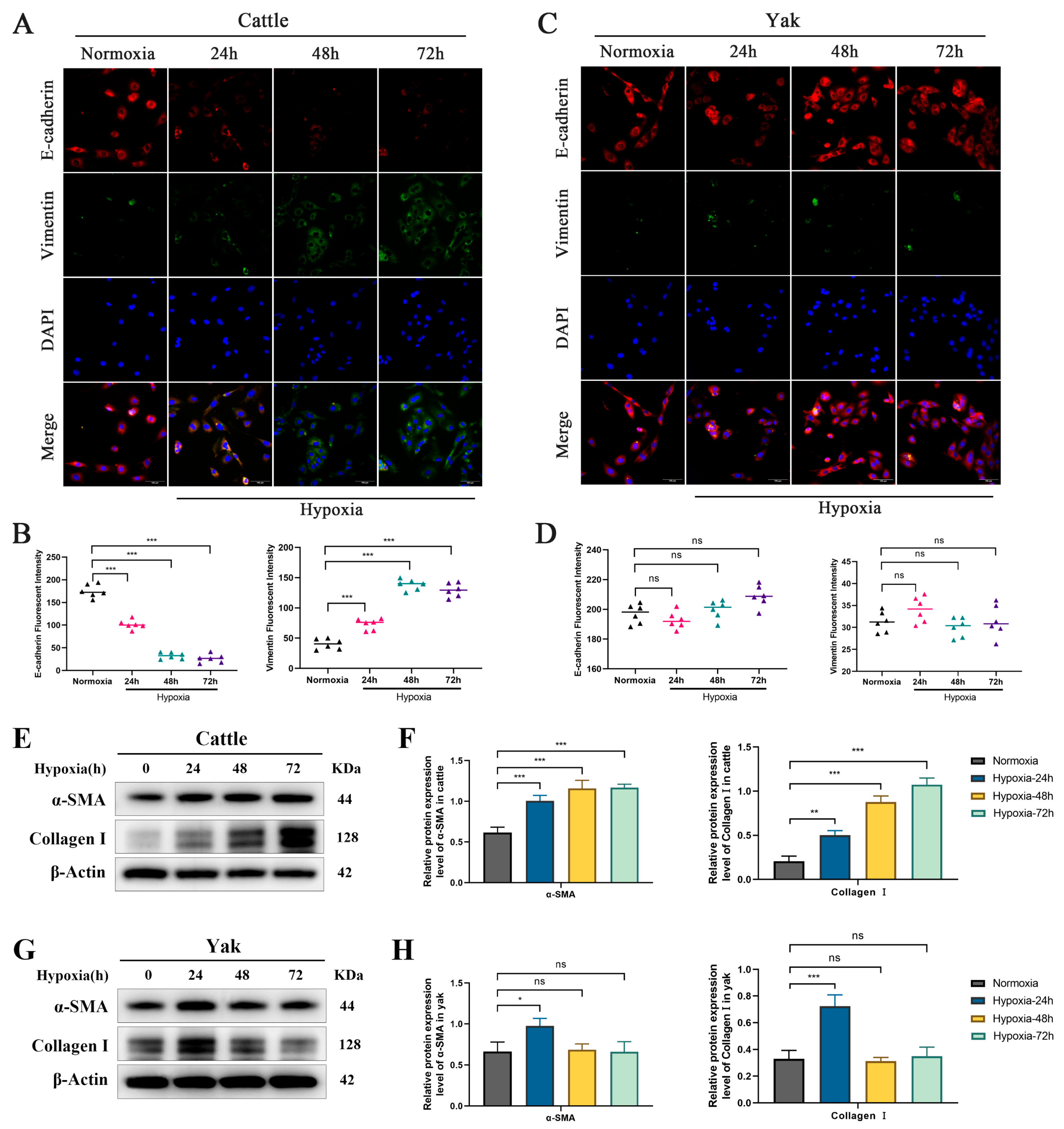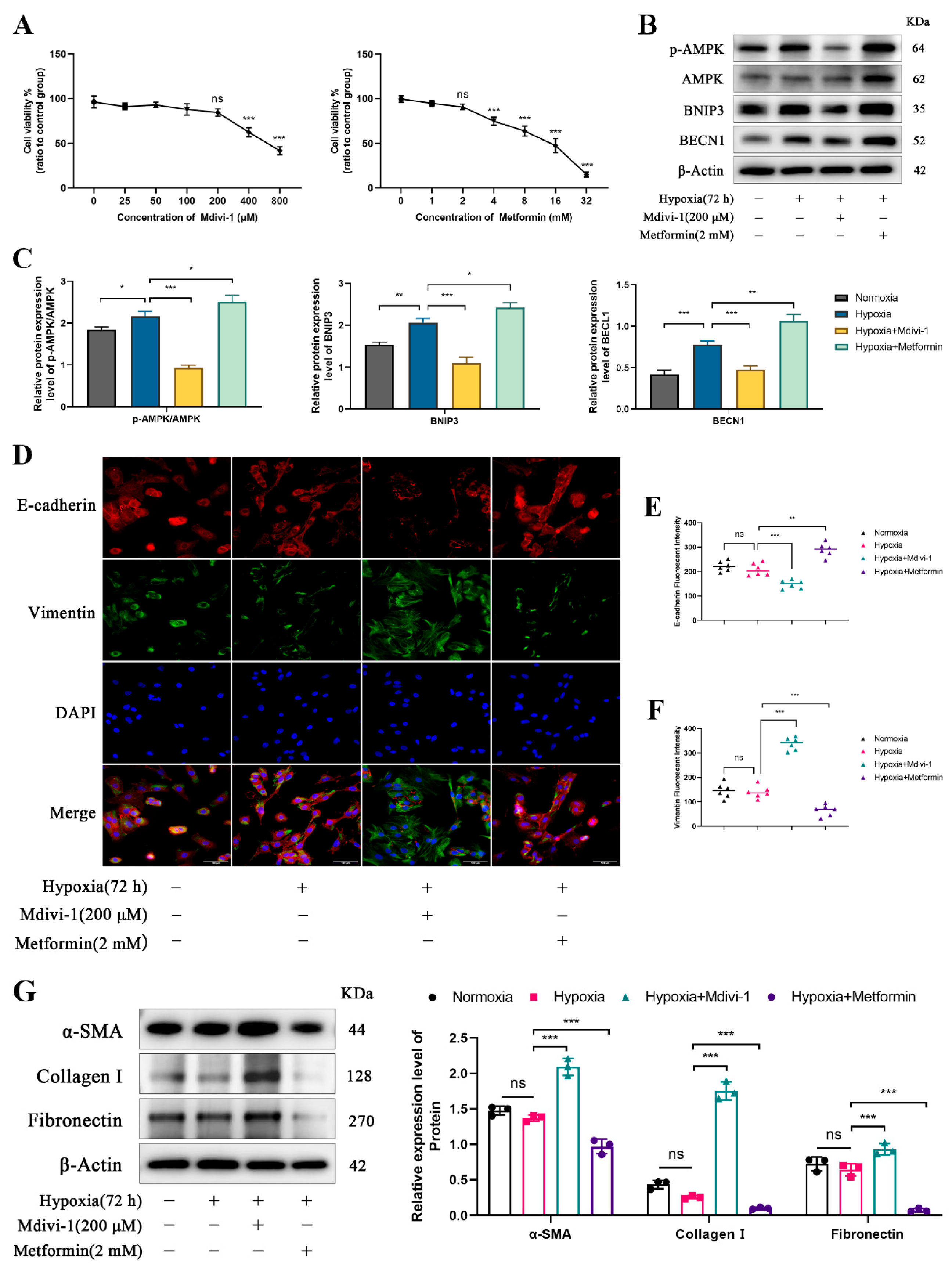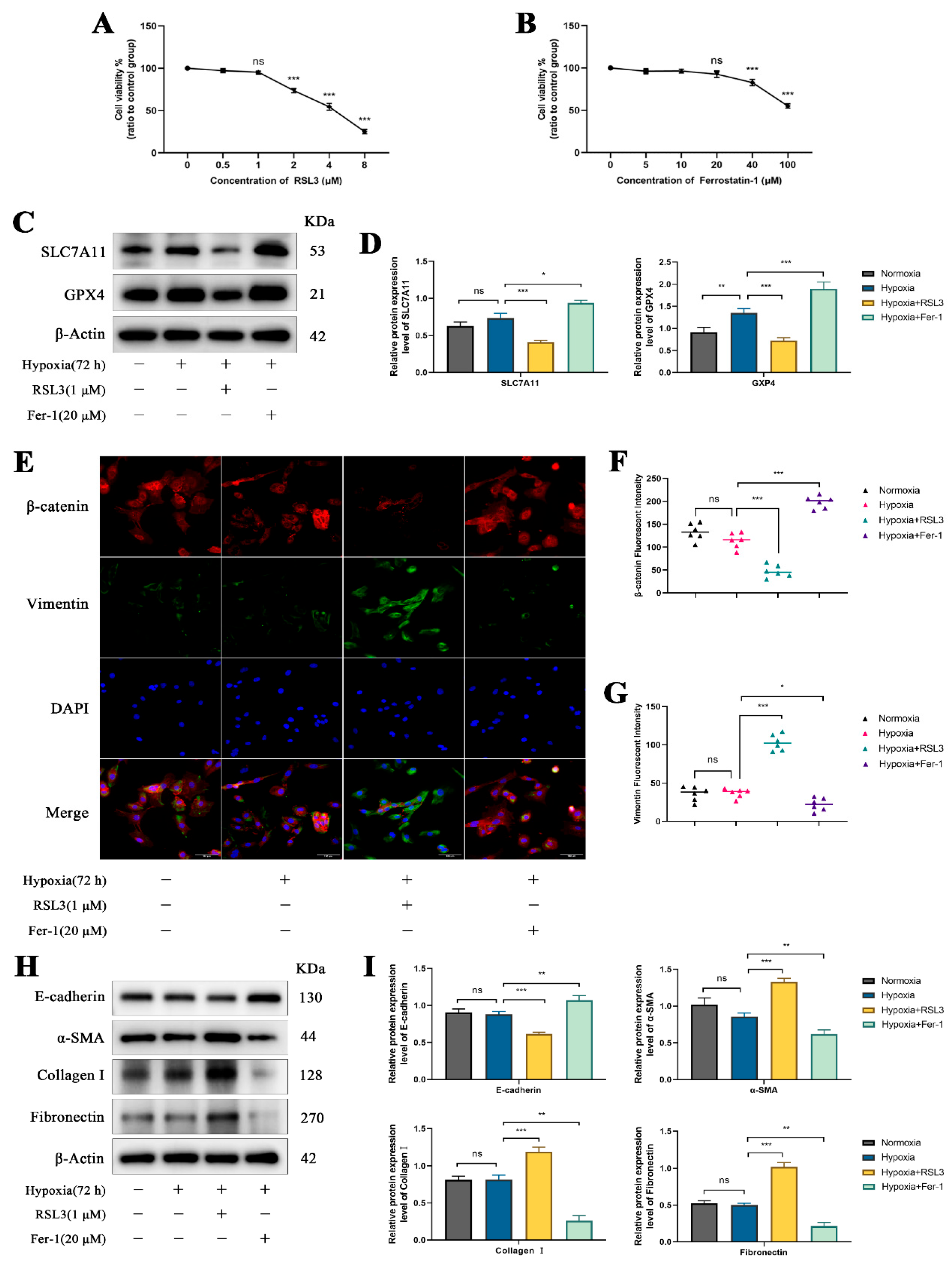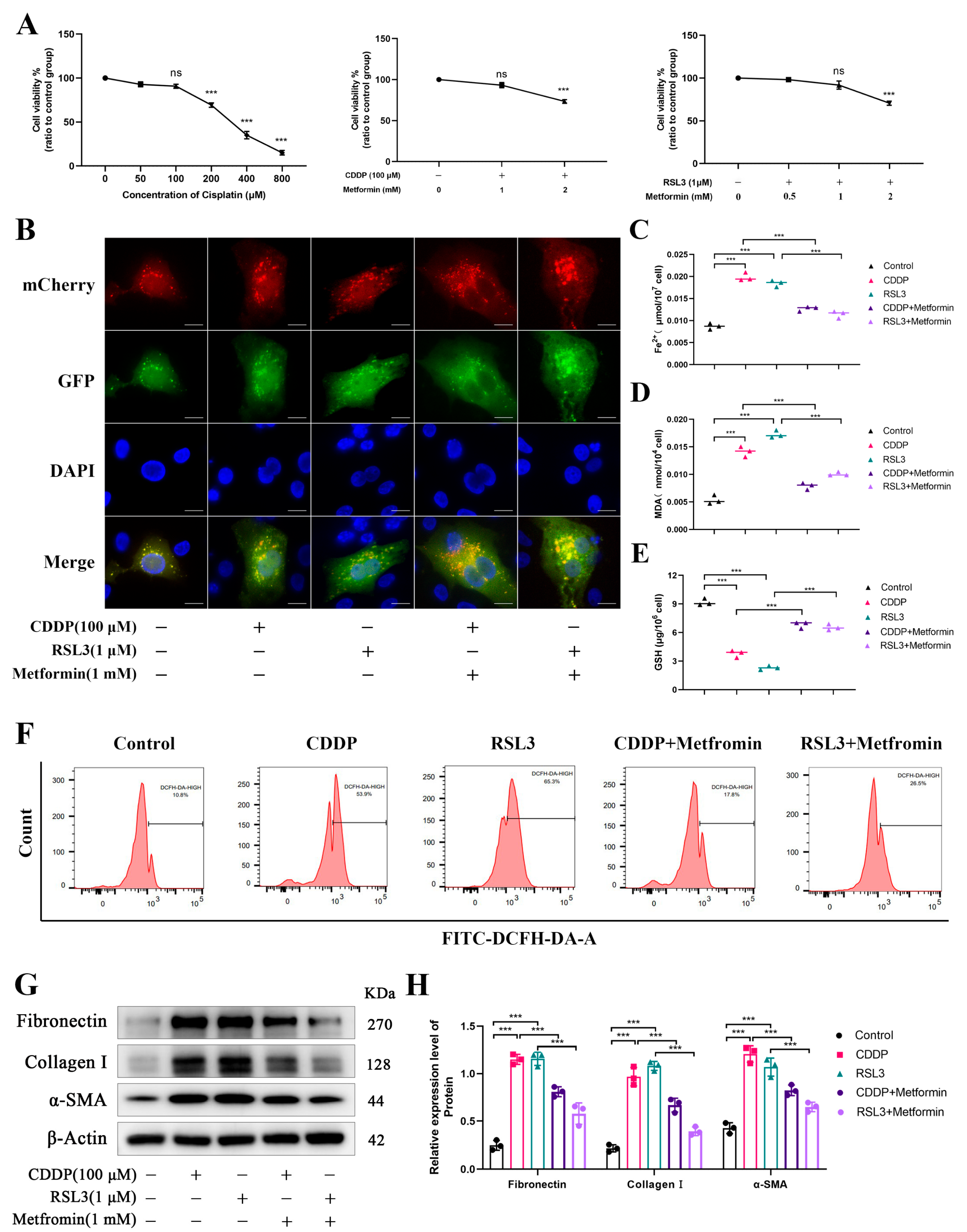1. Introduction
The kidneys are vital components of the urinary system, essential for maintaining homeostasis, regulating water-electrolyte and acid-base balance, and eliminating metabolic waste. Chronic kidney disease (CKD) is a prevalent condition that poses a significant threat to human health due to its high incidence and mortality rates. Kidney fibrosis is a hallmark of nearly all CKD and a major pathological factor driving progression to end-stage renal disease (ESRD) [
1]. Research has shown that kidney fibrosis is closely associated with chronic inflammation, excessive extracellular matrix (ECM) deposition, fibroblast activation, hypoxia, and oxidative stress [
2]. Among these factors, hypoxia plays a critical role in promoting renal fibrosis. Under hypoxic conditions, an insufficient oxygen supply activates hypoxia-inducible factors (HIFs), which regulate pathways such as TGF-β, Notch, PI3K/Akt, and NF-κB, inducing epithelial-to-mesenchymal transition (EMT) in RTECs, and thereby promoting fibrosis [
3]. However, yaks, an economically important species that has long inhabited high-altitude hypoxic environments, have developed unique physiological mechanisms to adapt to low-oxygen environment. Previous studies have shown that under hypoxic conditions, the expression of HIF-1α is upregulated in yak RTEC [
4]. Additionally, the expression level of HIF-1α in the lungs of yaks is significantly higher than that in cattle [
5]. These results suggest that although yaks are exposed to hypoxic conditions, their unique hypoxia adaptation mechanisms enable them to maintain homeostasis. Therefore, exploring the mechanisms by which yak kidneys are protected from hypoxia-induced fibrotic damage will not only help to understand the physiological characteristics of high-altitude adaptive organisms, but also provide new insights into the pathological mechanisms of renal fibrosis.
Ferroptosis is a recently identified form of iron-dependent cell death. Studies have shown that the depletion of intracellular glutathione (GSH) leads to a reduced activity of glutathione peroxidase 4 (GPX4). As a result, lipid peroxides cannot be metabolized through GPX4-catalyzed reduction reactions, and Fe
2⁺ oxidizes lipids in a Fenton-like manner, generating large amounts of reactive oxygen species (ROS), thereby promoting ferroptosis [
6,
7]. Therefore, the accumulation of Fe
2⁺ and lipid peroxidation are key characteristics of ferroptosis [
8]. Ferroptosis plays a critical role in the progression of various systemic diseases, such as myocardial ischemia/reperfusion injury (IRI), liver fibrosis, type 1 diabetes, acute kidney injury (AKI), and renal cell carcinoma [
9]. Studies has shown that characteristics of ferroptosis, including excessive iron accumulation and lipid peroxidation, are present during the development of kidney diseases [
10]. Animal experiments have demonstrated that the use of ferroptosis inhibitors (Ferrostatin-1) can attenuate the progression of fibrosis and suppress the release of pro-fibrotic factors in a mouse renal fibrosis model (UUO) [
11,
12]. Furthermore, in a CKD rat model, induced by 5/6 nephrectomy, the activation or inhibition of ferroptosis resulted in an increase or decrease, respectively, in renal fibrosis markers [
13]. These findings suggest that inhibiting ferroptosis is a potential therapeutic target for treating renal fibrosis.
Mitochondria, as the energy factories of cells, play a crucial role in cellular function. When mitochondrial function is impaired, it can lead to the accumulation of ROS, which in turn triggers a series of pathological reactions [
14]. To maintain mitochondrial quality and cellular health, cells activate the mitophagy pathway to selectively remove damaged or dysfunctional mitochondria. Notably, our previous research also demonstrated that mitophagy can regulate metabolic pathways to inhibit apoptosis in yak RTECs and maintain cellular homeostasis [
15]. Furthermore, with the advancement of research into the mechanisms of mitophagy, it has been shown to hold potential in the prevention and treatment of various diseases, especially those associated with oxidative stress, cell death, and fibrosis [
16,
17]. Studies have shown that Farrerol can alleviate cisplatin-induced CKD by activating the Parkin-mediated mitophagy pathway [
18]. The accumulation of ROS is one of the primary causes of ferroptosis and renal fibrosis, but mitophagy can reduce ROS production by degrading damaged mitochondria. It has been reported that AKI in RTECs induced by cisplatin leads to ferroptosis, while activation of mitophagy can alleviate ferroptosis and kidney injury [
19].
However, the regulatory mechanisms of mitophagy in protecting yak kidneys from fibrotic damage, particularly its role in modulating the ferroptosis pathway, have not yet been reported. Therefore, this study aims to elucidate the regulatory mechanisms of mitophagy in yak renal fibrosis and its effects on the ferroptosis pathway. The findings are expected to offer new theoretical insights and potential targets for understanding high-altitude adaptation mechanisms and for the prevention and treatment of hypoxia-related diseases.
2. Materials and Methods
2.1. Animals and Ethics
In this study, adult male yaks (4 years old, n = 6) from high-altitude regions (altitude > 3000 m) and adult male cattle (4 years old, n = 6) from low-altitude areas (1000 m) were selected as animal samples. All animals were clinically healthy. Tissue samples designated for histological analysis were fixed in 4% paraformaldehyde (PFA) at room temperature for one week. Samples intended for Western blot analysis were stored at −80 °C. For cell culture experiments, fresh kidney tissues were immediately immersed in sterile physiological saline and transported to the laboratory for primary cell culture. All experimental procedures were handled according to the Animal Ethics Procedures and Guidelines of the People’s Republic of China. This study was also approved by the Animal Ethics Committee of Gansu Agricultural University (GSAU-Eth-VMC-2023-004).
2.2. Histological Staining
Kidney samples from adult yaks and yellow-cattle were fixed in 4% PFA for one week. Subsequently, the samples were cut into 1 cm3 pieces, dehydrated for 24 h, embedded in paraffin, and sectioned into 4 μm-thick paraffin sections. Deparaffinization of these sections was achieved using xylene and alcohol in preparation for histological staining. H&E, Masson and Sirius red staining were performed following the instructions provided by the relevant reagent manufacturer (Solarbio, Beijing, China). We selected at least five slices from each group of samples. For every slice, three fields of view were randomly chosen, and photographs were taken using an Olympus-DP73 optical microscope (Olympus, Tokyo, Japan). To quantify collagen volume after Masson’s trichrome or Sirius red staining, we utilized Image-J 1.54software (National Institutes of Health, Bethesda, MD, USA) to analyze the percentage of the stained area in each randomly selected field of view relative to the total area. Importantly, all sample analyses were conducted in a blinded manner.
2.3. Immunohistochemistry Staining of Kidney Tissues
Paraffin-embedded tissue sections (4 μm) were deparaffinized using xylene and rehydrated through a series of graded ethanol solutions. After washing with distilled water, antigen retrieval was performed by boiling the sections in citrate buffer (pH 6.0) for 15 min. To block endogenous peroxidase activity, the sections were incubated with 3% hydrogen peroxide at room temperature for 10 min. Subsequently, the sections were incubated at 37 °C for 2 h with anti-P-AMPK (1: 300, AF3423, Affinity, Shanghai, China), anti-P-mTOR (1:300, AF3308, Affinity), anti-Parkin (1:300, 14060-1-AP, Proteintech, Wuhan, China), anti-PINK1 (1:100, DF7742, Affinity), anti-LC3 (1:300, 14600-1-AP, Proteintech), and anti-BECN1 (1:25, AF5128, Affinity) antibodies. Following the PBS washes, the slides were treated with a biotinylated secondary antibody and incubated at 37 °C for 15 min, and finally 3,3-diaminobenzidine (DAB) (Bios, Beijing, China) was used for color development. The sections were counterstained with hematoxylin. For negative controls, PBS (pH 7.4) was substituted for the primary antibody, while all other conditions remained unchanged. Photographs of each section were captured using an Olympus DP73 optical microscope (Olympus, Tokyo, Japan).
2.4. Cell Culture and Hypoxia Induction
Yak and cattle RTECs were primary cells, and the culturing methods have been detailed in our previous studies [
15]. RTECs were cultured in DMEM/F12 medium (Gibco, Grand Island, NE, USA) and contained 10% fetal bovine serum (FBS, Gibco, USA), penicillin (100 IU/mL, Solarbio, Beijing, China), and streptomycin (100 µg/mL, Solarbio, Beijing, China). The cells were cultured in an incubator at 37 °C and 5% CO
2. RTECs were exposed to normoxic conditions (37 °C, 21% O
2, 5% CO
2) and hypoxic conditions (37 °C, 5% O
2, 5% CO
2), respectively. Samples were collected every 24 h from the hypoxic treatment group for a total of 72 h to analyze changes at different hypoxic time points.
2.5. Western Blotting
After washing the kidney tissue samples and the RTEC samples with PBS, radioimmunoprecipitation assay lysis buffer (Solarbio, Beijing, China) was added to lyse the samples. The extracted protein was mixed with protein loading buffer (Solarbio, Beijing, China) and heated in a metal bath at 100 °C for 10 min to denature the proteins. Subsequent experiments were performed according to the Western blot protocol. Briefly, equal amounts of protein samples were separated by SDS-PAGE, followed by transfer to a 0.22 μm/0.45 μm PVDF membrane (Millipore, Burlington, MA, USA). The membrane was blocked with Tris-buffered saline with 0.1% Tween-20 and 5% BSA at room temperature for 2 h. Subsequently, the membrane was incubated overnight at 4 °C with specific primary antibodies: anti-P-AMPK (1:1000, AF3423, Affinity, Shanghai, China), anti-AMPK (1:1000, AF3423, Affinity), anti-P-mTOR (1:800, AF3308, Affinity), anti-mTOR (1:800, AF6308, Affinity), anti-LC3 (1:2000, 14600-1-AP, Proteintech, Wuhan, China), anti-Parkin (1:1500, 14060-1-AP, Proteintech), anti-PINK1 (1:1000, DF7742, Affinity), anti-E-cadherin (1:2000, AF0131, Affinity), anti-Fibronectin(1:2500, 15613-1-AP, Proteintech), anti-α-SMA(1:2000, AF0048, Beyotime, Shanghai, China), anti-Collagen Ⅰ (1:1500, AF7001, Affinity), anti-GPX4 (1:2000, 67763-1-Ig, Proteintech), anti-SLC7A11(1:1000, 26864-1-AP, Proteintech), and anti-β-actin (1:3000, bs-0061R, Bioss, Beijing, China). After washing the PVDF membrane with PBST, incubate it with HRP-conjugated secondary antibodies (goat anti-rabbit IgG or goat anti-mouse IgG, 1:3000, Bioss) at 37 °C for 1 h. The bands were then visualized using an enhanced chemiluminescent (ECL) detection reagent (Vazyme, Nanjing, China) and imaged with the Amersham Imager 600 chemiluminescence imaging system (GE Healthcare BioSciences AB, Uppsala, Sweden). The images were quantified by densitometry using Image J software. The relative expressions of the proteins were normalized to β-actin.
2.6. Mitochondrial-Lysosomal Co-Localization
For mitochondrial and lysosomal localization in RTECs, the following procedure was used: cells were seeded in 6-well plates and incubated with Mito-Tracker Green (Beyotime, Shanghai, Beijing) at 37 °C for 30 min to stain the mitochondria. After washing, Lyso-Tracker Red (Beyotime, Shanghai, Beijing) was added and incubated at 37 °C for an additional 15 min to label the lysosomes. Nuclei were stained with Hoechst 33342 (Beyotime, Shanghai, Beijing). Images were captured using a fluorescence microscope (Olympus-DP71, Tokyo, Japan). This protocol allows for simultaneous visualization of mitochondria and lysosomes.
2.7. Drug Treatment
In the drug treatment experiments, RTECs were seeded into 96-well plates. After hypoxia induction for 48 h, cells were treated with specific drugs at varying concentrations to evaluate their effects under hypoxic conditions. The drugs included Mdivi-1 (mitophagy inhibitor, Med Chem Express): 0, 25, 50, 100, 200, 400, and 800 µM; Metformin (mitophagy activator, Med Chem Express): 0, 1, 2, 4, 8, 16, and 32 mM; RSL3 (ferroptosis activator, Med Chem Express): 0, 0.5, 1, 2, 4, and 8 µM; Ferrostatin-1 (ferroptosis inhibitor, Med Chem Express): 0, 5, 10, 20, 40, and 100 µM; and Cisplatin (renal fibrosis activator, Med Chem Express): 0, 5, 10, 20, 40, 80, and 100 µM. Following the drug treatment, cells were maintained under hypoxic conditions for an additional 24 h. The CCK-8 assay was used to assess cell viability, and the results were analyzed to determine the optimal concentrations of each drug for subsequent experiments.
2.8. Mitochondrial Membrane Potential Detection
RTECs were seeded into 6-well plates and subjected to hypoxic conditions or drug treatments according to the experimental design. Following treatment, cells were collected by trypsin digestion and resuspended in PBS. A 100 µL aliquot of the cell suspension was transferred into a flow cytometry tube, and 300 µL of prepared JC-10 probe solution (AAT Bioquest, Pleasanton, CA, USA) was added. The samples were incubated in the dark for 30 min. After incubation, unbound probes were washed off, and the mitochondrial membrane potential was assessed using a flow cytometer (Beckman, Brea, CA, USA). The resulting data were analyzed with Modfit LT 5.0 software.
2.9. ROS Assessment
To use the DCFH-DA probe (Solarbio, Beijing, China) to detect ROS in RTECs, dilute the probe to a final concentration of 1 μmol/L in serum-free culture medium. After removing the cell culture medium, add 1 mL of the diluted DCFH-DA solution to the cells and incubate at 37 °C in a cell culture incubator for 30 min. After incubation, wash cells thoroughly with PBS to remove unincorporated DCFH-DA probe. ROS staining results can be observed using a fluorescence microscope (Olympus DP 71, Tokyo, Japan) or ROS levels can be assessed using a flow cytometer (Beckman, Brea, CA, USA).
2.10. Lipid Peroxidation Staining
RTECs were seeded in a 6-well plate and cultured for 24 h before drug treatment. After treatment, an appropriate amount of Lipid Peroxidation Probe (BODIPY 581/591 C11, Beyotime, Shanghai, China) was added to each well at a final concentration of 2 μM. The cells were then incubated in a cell culture incubator for 20 min. After incubation, the supernatant was removed, and the cells were washed twice with PBS. Subsequently, 2 mL of PBS was added, and fluorescence imaging was performed using a fluorescence microscope. The reduced form of BODIPY 581/591 C11 emits red fluorescence, with maximum excitation/emission wavelengths of 581/591 nm. Upon oxidation, the fluorescence shifts to green, with an excitation/emission peak at 488/510 nm.
2.11. Determination of GSH, MDA and Fe2+
The expression levels of GSH, MDA, and Fe2⁺ are important indicators for evaluating ferroptosis. In this study, the Reduced Glutathione (GSH) Content Assay Kit, Malondialdehyde (MDA) Content Assay Kit, and Ferrous Ion (Fe2⁺) Content Assay Kit (Solarbio, Beijing, China) were used to detect the levels of GSH, MDA, and Fe2⁺ in RTECs after drug treatment. The detection was carried out according to the reagent manufacturer’s instructions. Each experiment was performed in triplicate to ensure the reliability and reproducibility of the results.
2.12. Immunofluorescence
RTECs were seeded onto coverslips and fixed with 4% PFA for 30 min. To increase cell membrane permeability, cells were incubated with 0.5% Triton X-100 (Beyotime, Shanghai, China) at room temperature for 10 min. Afterward, the cells were blocked with 5% BSA for 1 h to prevent nonspecific binding. Next, primary antibodies against E-cadherin (1:250, AF0131, Affinity), β-catenin (1:200, AF6266, Affinity) and Vimentin (1:500, ab8069, Abcam, Cambridge, MA, USA) were added and incubated overnight at 4 °C. After the incubation, secondary antibodies, anti-Rabbit IgG (H+L)-Alexa Fluor 594 (A-11012, Thermo, Waltham, MA, USA) and anti-Mouse IgG (H+L)-Alexa Fluor 488 (A-11001, Thermo, Waltham, MA, USA), were applied for 1 h at room temperature in the dark. Finally, cell nuclei were stained with DAPI (10 μg/mL). Images were captured using a fluorescence microscope (Olympus DP71, Tokyo, Japan).
2.13. Fluorescence Staining of Autophagosomes
Ad-mCherry-GFP-LC3B was used to detect autophagosome formation in yak RTECs. Briefly, RTECs were seeded in 6-well plates. When the cell confluence reached 70–80%, the cells were infected with Ad-mCherry-GFP-LC3B adenovirus (Beyotime, Shanghai, China). After treatment, the nuclei were stained with DAPI (10 µg/mL) for 5 min. The intracellular fluorescence of Ad-mCherry-GFP-LC3B was observed under a fluorescence microscope (Olympus DP 71, Tokyo, Japan).
2.14. Statistics Analyses
The data are presented as the means ± standard errors of the means (S.E.M.) from three independent experiments and were analyzed using GraphPad Prism 8.3.0 software (GraphPad Software, San Diego, CA, USA). Differences between two groups were analyzed using two-tailed Student’s t tests. For comparisons involving multiple groups with more than one variable, two-way ANOVA followed by post hoc Tukey’s test was applied. A p value < 0.05 was considered to indicate statistical significance.
4. Discussion
Renal fibrosis is a critical pathological feature in the progression of CKD, regulated by various factors, including hypoxia, inflammation, oxidative stress, and epithelial cell injury [
2]. Among these, hypoxia plays a crucial role in driving renal fibrosis. In a hypoxic environment, insufficient oxygen supply to renal tissues activates hypoxia signaling pathways, which subsequently upregulate the expression of multiple pro-fibrotic factors [
20,
21]. These factors not only promote fibroblast activation but also induce aberrant accumulation of ECM, thereby exacerbating fibrotic progression [
22]. However, the impact of hypoxia on the kidneys may differ depending on species-specific adaptive mechanisms. Yaks, which have long inhabited high-altitude hypoxic environments, yet no studies have shown that hypoxia induces kidney disease in yaks. In this study, by comparing the renal tissue structures of cattle and yaks, we observed that yaks have a significantly higher number of renal tubules than cattle. Renal tubules play a crucial role in water reabsorption and in regulating fluid and acid-base balance. High-altitude environments are often accompanied by low temperatures and dryness, which can lead to water loss. Therefore, we speculate that an increased number of renal tubules may help yaks more effectively retain body fluids and electrolytes, thereby maintaining fluid balance and normal physiological functions. Additionally, collagen volume analysis indicated no significant difference in volume fraction between the two species. This result suggests that yaks may have developed anti-fibrotic mechanisms during prolonged hypoxic adaptation. However, the molecular mechanisms by which yaks avoid hypoxia-induced renal fibrosis have not been reported.
In our previous research, we identified mitophagy as a pivotal regulatory mechanism for maintaining mitochondrial homeostasis in yaks [
15]. Notably, mitochondrial dysfunction can lead to RTEC injury and accelerate the progression of renal fibrosis [
23,
24]. Therefore, we hypothesized that yaks might activate the mitophagy pathway in high-altitude hypoxic environments to protect their kidneys from fibrotic damage. To validate this hypothesis, we compared the expression levels of mitophagy-related proteins in the kidneys of cattle and yaks. The results demonstrated a significant upregulation of P-AMPK/AMPK, Parkin, PINK1, LC3 Ⅱ/Ⅰ, and BECN1, along with a downregulation of P-mTOR/mTOR in yak kidneys under hypoxia. BNIP3 has been widely recognized as a key regulator of mitophagy [
25], primarily by disrupting the interaction between Bcl-2 and BECN1, thereby releasing BECN1 to promote autophagosome formation [
26]. Meanwhile, hypoxia inhibits oxidative phosphorylation, reducing ATP levels and activating AMPK. Activated AMPK suppresses the mTOR pathway, relieving its inhibitory effect on mitophagy [
27,
28]. Collectively, these findings indicate that hypoxia activates the mitophagy pathway in the yak kidney, potentially playing a protective role in the adaptation of yak kidneys to hypoxic environments and inhibiting fibrosis progression.
EMT is a critical pathological process in renal fibrosis. Under hypoxic conditions, EMT causes RTECs to gradually lose their epithelial phenotype and acquire migratory mesenchymal characteristics [
29]. This process is characterized by a decrease in E-cadherin expression and an increase in Vimentin, α-SMA, and FN1 expression. Our study found that under chronic hypoxia, mitophagy activation effectively inhibited the expression of Vimentin, α-SMA, Collagen Ⅰ, and FN1, suggesting that mitophagy may play a protective role in EMT progression and renal fibrosis. This result is consistent with previous studies. Multiple studies have confirmed that mitophagy not only alleviates hypoxia-induced renal fibrosis but also has therapeutic effects on other kidney diseases. For instance, Mdivi-1, a mitochondrial inhibitor, can reduce the expression levels of PINK1, PARK2, and LC3II, activate the TGF-β1 signaling pathway in HK-2 cells under hypoxic conditions, thereby exacerbating renal fibrosis [
30]. Additionally, mitophagy can inhibit the expression of fibrosis-related proteins through the AMPK/mTOR signaling pathway, ultimately preventing the progression of renal fibrosis [
31]. In studies on ischemia/reperfusion (I/R)-induced acute kidney injury (AKI), it was found that HIF-1α-BNIP3 can induce mitophagy in HK-2 cells, inhibit apoptosis and ROS production in AKI, thereby exerting a protective effect on the kidney [
25]. Another study also showed that mitophagy inhibits the occurrence of AKI by reducing the activation of the NOD-like receptor protein 3 (NLRP3) inflammasome, which plays a crucial role in the pathogenesis of AKI [
32].
Ferroptosis is an iron-dependent form of cell death, characterized by elevated intracellular ROS levels, lipid peroxidation accumulation, and disruption of the GSH/GPX4 antioxidant system [
33]. Under hypoxic conditions, HIF-1α inhibits the expression of SLC7A11, reducing cellular cysteine uptake, which subsequently lowers GSH levels and inhibits GPX4 activity [
34]. This change prevents the effective clearance of lipid peroxides, ultimately inducing ferroptosis. Concurrently, oxidative stress triggered by ferroptosis can activate the NF-κB signaling pathway, leading to the release of pro-inflammatory factors such as interleukin-6 (IL-6) and tumor necrosis factor-alpha (TNF-α). These inflammatory factors further stimulate the TGF-β1 pathway, inducing EMT and thereby accelerating fibrosis progression. However, our study revealed that yak RTECs did not exhibit an enhanced trend of ferroptosis under chronic hypoxia and maintained normal expression of SLC7A11 and GPX4. Notably, when ferroptosis was modulated in yak RTECs using RSL3 (ferroptosis inducer) or Ferrostatin-1 (ferroptosis inhibitor), EMT and fibrosis were, respectively, promoted or inhibited. These findings suggest that the hypoxic adaptation mechanisms in yaks effectively suppress hypoxia-induced ferroptosis, thereby mitigating renal fibrosis progression.
In the recent years, increasing evidence has highlighted a close relationship between ferroptosis and mitophagy in the regulation of renal fibrosis. Studies have demonstrated that during ferroptosis, mitochondria undergo morphological changes, including shrinkage, increased membrane density, cristae disappearance, and outer membrane rupture [
35]. These alterations lead to mitochondrial dysfunction and excessive ROS accumulation, further exacerbating ferroptosis. However, mitophagy can clear damaged mitochondria, reduce ROS production, and prevent GPX4 inactivation and lipid peroxidation accumulation, thereby effectively inhibiting ferroptosis [
17]. Our study similarly revealed that under chronic hypoxia, mitophagy activation significantly reduced ROS and lipid peroxides while upregulating SLC7A11 and GPX4 expression. However, recent research has proposed different perspectives, suggesting that mTOR inhibition can enhance mitophagy-mediated GPX4 degradation, thereby promoting ferroptosis in bladder cancer cells [
36]. Additionally, the AMPK pathway can phosphorylate BECN1 at Ser90/93/96 sites, facilitating the formation of the BECN1-SLC7A11 complex, which induces lipid peroxidation and ferroptosis [
37]. These studies underscore the complex role of mitophagy in ferroptosis. Nevertheless, our study supports the view that mitophagy inhibits ferroptosis. In our study, we found that in a cisplatin-induced renal fibrosis model, both mitophagy and ferroptosis pathways were activated. However, either activating mitophagy or inhibiting ferroptosis effectively suppressed fibrosis-related protein expression induced by cisplatin. Furthermore, mitophagy activation significantly reduced ROS and MDA levels while promoting GSH expression in the fibrosis model. Therefore, our study suggests that under chronic hypoxia, mitophagy serves as an adaptive protective mechanism that protects yak kidneys from hypoxia-induced fibrosis by inhibiting ferroptosis.
In addition to mitophagy activation, other antifibrotic mechanisms may play significant roles in mitigating hypoxia-induced renal fibrosis. Studies have shown that HIF-2α activated under hypoxic conditions can improve tubulointerstitial oxygenation, promote angiogenesis, and inhibit the expression of fibrosis-related genes, thereby reducing tubulointerstitial injury and renal fibrosis [
38,
39]. Moreover, in a UUO of renal fibrosis in mice, erythropoietin (EPO) treatment was found to suppress the accumulation of myofibroblasts and the expression of α1(I) collagen mRNA, ultimately alleviating the progression of renal fibrosis [
40]. Interestingly, our previous work demonstrated that hypoxia significantly induces EPO expression in yak kidneys [
4]. Furthermore, enhanced glycolysis under hypoxia represents another important mechanism for reducing fibrosis. Research indicates that increased glycolysis leads to hyperacetylation of mitochondrial proteins, and the deacetylation of the pyruvate dehydrogenase complex (PDC) at lysine 385 can be significantly reversed, thereby improving renal fibrosis [
41]. However, whether these mechanisms are involved in protecting yaks from hypoxia-induced renal fibrosis requires further investigation.













